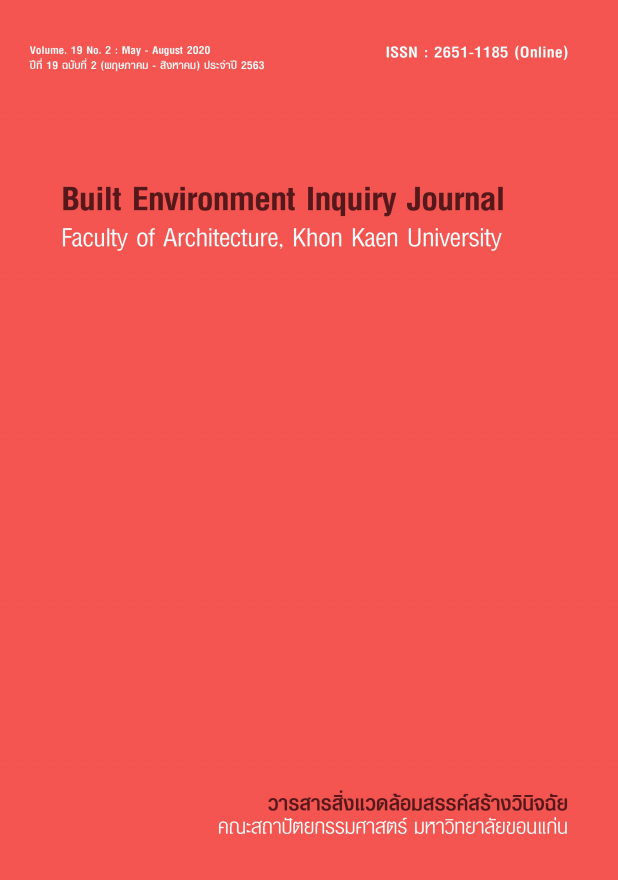องค์ประกอบที่สร้างเอกลักษณ์ของภูมิทัศน์วัฒนธรรมไทยในบริบทร่วมสมัย: กรณีศึกษาชุมชนปากพะยูน จังหวัดพัทลุง
คำสำคัญ:
ภูมิทัศน์วัฒนธรรม, เอกลักษณ์, องค์ประกอบของภูมิทัศน์วัฒนธรรม, ชุมชนปากพะยูนบทคัดย่อ
บทความนี้มีวัตถุประสงค์เพื่อศึกษาองค์ประกอบของภูมิทัศน์วัฒนธรรมชุมชนปากพะยูน อำเภอปากพะยูน จังหวัดพัทลุง ในบริบทร่วมสมัย และศึกษาเอกลักษณ์ของภูมิทัศน์วัฒนธรรมของชุมชนปากพะยูน เพื่อเป็นแนวทางการอนุรักษ์ภูมิทัศน์วัฒนธรรมสำหรับเทศบาลตำบลปากพะยูน ตลอดจนส่งเสริมให้ประชากรในชุมชนปากพะยูน ตระหนักถึงคุณค่าและความสำคัญของเอกลักษณ์ของภูมิทัศน์วัฒนธรรมชุมชนปากพะยูน โดยใช้วิธีวิจัยแบบผสมผสาน 5 วิธีร่วมกัน ได้แก่ การทบทวนวรรณกรรมและงานวิจัยที่เกี่ยวข้อง การสำรวจภาคสนาม การสัมภาษณ์ การใช้ภาพตัวแทน และแบบสอบถาม ผลการวิจัยพบว่าองค์ประกอบของภูมิทัศน์วัฒนธรรมชุมชนปากพะยูนเกิดจาก 5 องค์ประกอบ คือ องค์ประกอบด้านกายภาพ องค์ประกอบด้านสังคมวัฒนธรรม องค์ประกอบด้านประวัติศาสตร์ องค์ประกอบด้านเศรษฐกิจ และองค์ประกอบด้านการเมือง ซึ่งองค์ประกอบดังกล่าวมีความสัมพันธ์และส่งผลซึ่งกันและกัน และผสานกันจนเกิดเป็นภูมิทัศน์วัฒนธรรมชุมชนปากพะยูน ทั้งนี้ผลจากแบบสอบถามและการเลือกภาพตัวแทนพบว่า เอกลักษณ์หลักของภูมิทัศน์วัฒนธรรมชุมชนปากพะยูน คือ อาหารทะเล การทำประมง ลักษณะภูมิประเทศ การอยู่ร่วมกันของ 2 ศาสนา มัสยิดกลางประจำจังหวัดพัทลุง ตลาดปากพะยูน และทัศนียภาพชุมชนส่วนเอกลักษณ์รอง ได้แก่ สถาปัตยกรรมพื้นถิ่น วัดรัตนาราม รูปแบบการตั้งถิ่นฐาน สถานที่ท่องเที่ยว ท่าเรือปากพะยูน ตลาดท่าใหญ่ และกุโบร์ ซึ่งเอกลักษณ์ดังกล่าวเกิดจากการผสานขององค์ประกอบของภูมิทัศน์วัฒนธรรมด้านสังคม และวัฒนธรรมและด้านกายภาพที่มีความโดดเด่นมากกว่าด้านประวัติศาสตร์ ด้านเศรษฐกิจ และด้านการเมือง
เอกสารอ้างอิง
Anambutr, R., & Suksawang, W. (2012). Khūmư̄kānpramœ̄nphon krathop thāng sāitāčhāk singkō̜sāng praphēt ʻākhān. (in Thai) [Visual impact assessment manual]. Bangkok: Office of Natural Resources and Environmental Policy and Planning.
Bunpiam, S. (2011, September 22). Sātsanā ... sāhēt khwāmkhatyǣng rư̄ khrư̄angmư̄ kǣ khwāmrunrǣng chāidǣn tai. (in Thai) [Religion ... Causes conflict or tools to combat southern border violence], Retrieved from https://www.isranews.org/isranewsscoop/3665.html
Chapanond, P. (1983). Cultural geography. Bangkok: Department of Geography, Faculty of Social Sciences.
Chuven, Y. (1986). Phatthanākān khō̜ng chumchon rō̜p thalēsāp song khlā tangtǣ ton Khritsatawat thī sipčhet thưng plāi Khritsatawat thī sippǣt. (in Thai) [The history of the lake of Songkhla region from the beginning of the seventeen of the ends of the eighteenth centuries]. Retrieved from http://www.thapra.lib.su.ac.th/thesis/showthesis_th.asp?id=0000004187
De Blij, H. (1997). Human geography: Culture, society and space. New York: John Wiley & Sons.
Eksaphang, U. (2004). Watthanatham nai kān damrong chīwit tām withī chāo phut nai sām čhangwat chāidǣn tai. (in Thai) [Living culture as Buddhist way of life in three southern border Provinces]. Retrieved from https://soreda.oas.psu.ac.th/show_detail.php?research_id=91
Fowler, P. (2002). World heritage cultural landscapes, 1992-2002. Paris: UNESCO World Heritage Centre
Jussapalo, C. (2018). Kānphatthanā sakkayaphāp kānthō̜ngthīeo phāitai ʻattalak læ withī khō̜ng thō̜ngthin lumnam thalēsāp : nakhō̜n sī tham rāt phatthalung læ song khlā . (in Thai) [Development of tourism potential in local identity and livelihood along Lake Basin: Nakornsri-Thammarat, Pattalung, and Songkhla]. Retrieved from https://elibrary.trf.or.th/project_content.asp?PJID= RDG5950124
Keokan, P. (1997). Kānkhā thāng rư̄a bō̜riwēn lum thalē song khlā. (in Thai) [Boat trading in the area of Songkhla Lake Basin]. Retrieved from http://slbkb.psu.ac.th/jspui/handle/2558/1073
Kirdsiri, K. (2008). Chumchon kap phū mi that watthanatham. (in Thai) [Community and cultural landscape]. Bangkok: Usakane.
Knox, P. L. (2001). Human geography: Places and regions in global context. New Jersey: Prentice Hall.
Lennon, J., & Mathews, S. (1996). Cultural landscape management. Canberra: Australian Alps Liaison Committee.
Muenharn, T. (2009) Kānraprū lædō̜ nœ̄n chīwit bǣp sangkhom phō̜pramān (MOSO) khō̜ng prachāchon nai čhangwat nonthabura. (in Thai) [Perception and moderation society lifestyle of people in Nonthaburi province]. Nonthaburi: Rajapruk University.
Nhunanan, T. (2019, September 3). Interview. Personal communication.
Osiri, N. (2008). Teaching documents of introduction to landscape architecture. Bangkok: Department of Landscape Architecture, Chulalongkorn University.
Phungsoonthorn, W. (Ed.). (2006). Nǣothāng kānčhatkān phū mi that watthanatham. (in Thai) [Guidelines for managing cultural landscapes]. Bangkok: Amarin Printing and Publishing.
Pongprayoon, C. (1984). Nǣo khwāmkhit thāng phūmisāt. (in Thai) [Geographic concepts]. Bangkok: Thai Wattana Panit.
Pongsabut, P. (1991). Phūm lak prathēt Thai. (in Thai) [Illustrated landform of Thailand] Bangkok: Darnsutha Press.
Sauer, C.O. (1967). Land and life: A selection of the writing of Carl Ortwin Sauer. Berkeley: University of California Press.
Sinsanengkaeo, S. (2009). Nǣothāng kān prap plīan phūm that watthanatham tām khrōngkān namrō̜ng kānbō̜rihān čhatkān læ phatthanā phư̄nthī kān kasēt pen phư̄nthī rō̜ng rap namnō̜ng phư̄a banthao ʻuthokkaphai tām nǣo phrarātchadamri kǣmling ʻamphœ̄ bāng bān čhangwat Phra Nakhō̜n Sī ʻAyutthayā. (in Thai) [Adaptation guidelines for cultural landscape regards to the management and development of agricultural area in mitigation of floods according to the Royal initiative pilot project monkey cheek in Bangbal Phanakorn Sri Ayutthaya province (Unpublished master’ thesis). Bangkok: Chulalongkorn University.
Siripattanakul, H. (2007). Phū mi that watthanatham?. (in Thai) [Cultural landscape?]. Retrieved from http://www.icomosthai.org/iTH_news/download/Newsletter10-1.pdf
ICOMOS Thailand. (2011). kot bat prathēt Thai wādūai kānbō̜rihān čhatkān lǣng mō̜radok watthanatham. (in Thai) Thailand charter on cultural heritage sites management.Retrieved from http://www.icomosthai.org/THcharter/63546_Charter_updated.pdf
The Heritage Council of Victoria. (2009). Landscape assessment guidelines for cultural heritage significance. Victoria: Heritage Council of Victoria.
Thongrak, S. (2003). Wiwatthanākān khō̜ng kānchai prayōt čhāk thīdin læ pāmai bō̜riwēn lumnam thalēsāp song khlā [Evolution of land uses and forest land uses in Songkhla Lake Basin]. (in Thai) Retrieved from http://kb.psu.ac.th/psukb/handle /2553/5199
Thongsaart, S. (1981). phūmisāt watthanatham. (in Thai) [Cultural geography]. Bangkok: Department of Geography, Faculty of Arts, Silpakorn University.
UNESCO (2005) Operational guidelines for the implementation of the World Heritage Convention. Paris: UNESCO World Heritage Centre.
Vogeler, I. (2010). Critical cultural landscape of North America. Retrieved from https://people.uwec.edu/ivogeler/CCL-bookchapters-pdf/index.htm
Scheinman, A. (2003). Criteria for the Identification of Cultural Heritage Landscapes: Town of Caledon. Retrieved from https://www.caledon.ca/en/live/ resources/Criteria_for_the_IDof_Cultural_Heritage_Landscapes.pdf
Walipodom, S., & Prasongbandit, S. (2003). praphēnī sip sō̜ng dư̄an : phithīkam thī plīan pai. (in Thai) [12 month tradition: Changing rituals]. Bangkok: Princess Maha Chakri Sirindhorn Anthropology Centre.
Wagner, P.L, & Mikesell, M.W. (1962). Reading in cultural geography. Chicago: University of Chicago Press.
Zube, E.H. (1987). Perceived land use patterns and landscape values. Landscape Ecol 1, 37-45.
ดาวน์โหลด
เผยแพร่แล้ว
รูปแบบการอ้างอิง
ฉบับ
ประเภทบทความ
สัญญาอนุญาต
ทัศนะและข้อคิดเห็นของบทความที่ปรากฏในวารสารฉบับนี้เป็นของผู้เขียนแต่ละท่าน ไม่ถือว่าเป็นทัศนะและความรับผิดชอบของกองบรรณาธิการ




